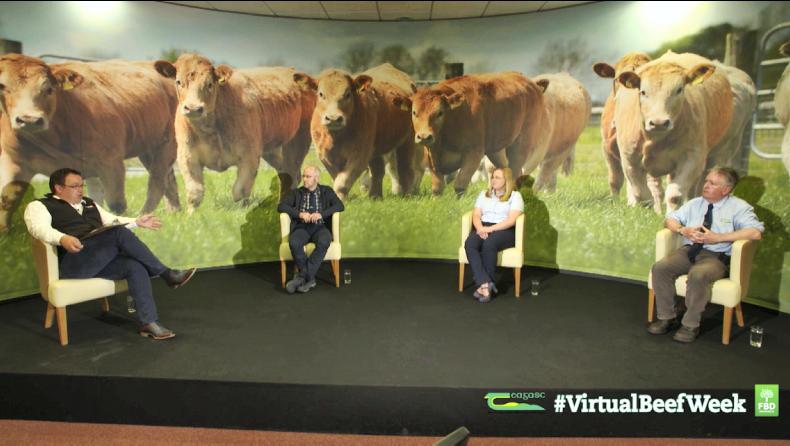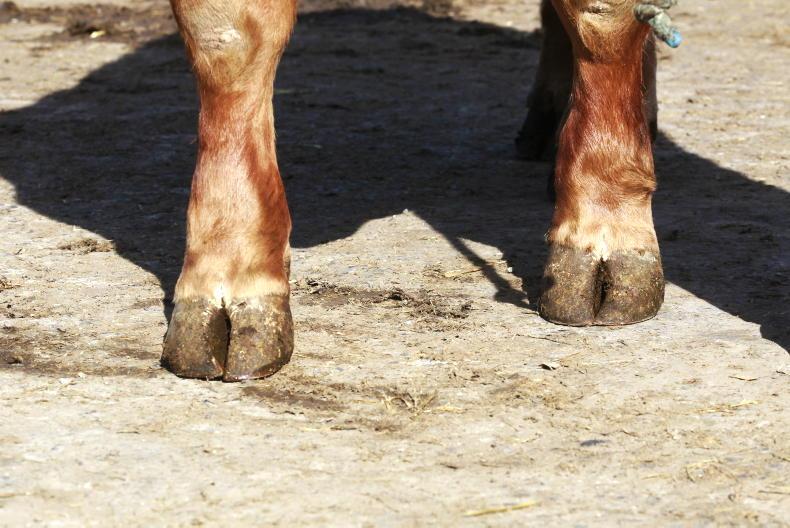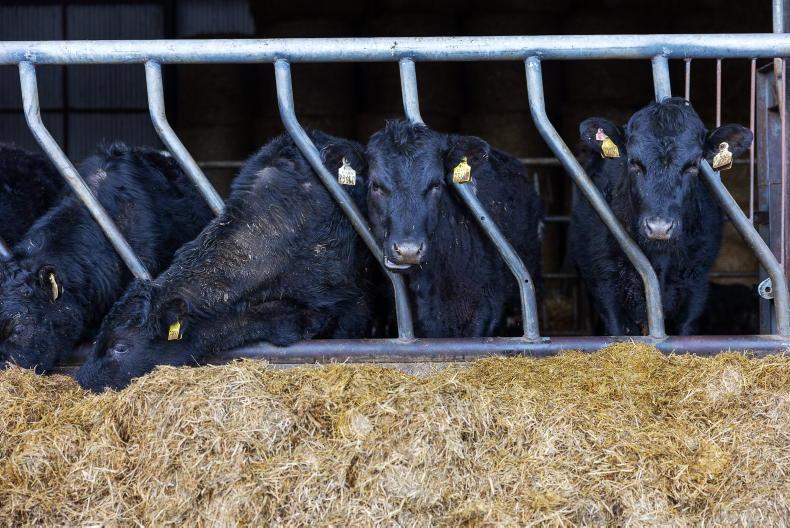Beef Talk – Ep 4: Grass Management for Sustainable Beef Production.
A leading Teagasc researcher says there is huge room for improvement for increased weight gains in animals on beef farms.
Dr Mark Magee was speaking with Adam Woods on the Teagasc virtual beef show hosted on farmersjournal.ie on Thursday.
Magee said: “We are losing 30kg to 40kg for the first season, 50kg to 60kg for the second season and the finisher is trying to compensate for that lost weight gain during an expensive period in the animal’s lifetime. If an animal is underfed and gains less than 0.3kg/day for that first winter, they will always be behind.”
If an animal doesn’t hit these targets weights early in their lifetime, the animal is essentially playing catchup for the rest of their lifetime and for some animals that do really poorly for their first winter, they will never make up that lost weight gain.
Feeding ‘weanlings’ during the winter
To minimise feed costs and exploit subsequent compensatory (“catchup”) growth at pasture during the following grazing season, liveweight gains of 0.5kg to 0.6kg/day through the first winter are acceptable for steers, heifers and suckler bulls destined to return to pasture in spring.
Research
Research at Teagasc Grange has shown that there is little point in over-feeding weanlings in winter as, during the subsequent grazing season, cattle that gained less over the winter had the highest liveweight gain at pasture, resulting in most of the winter weight advantage "disappearing" by the end of the grazing season.
However, cattle growing too slowly during winter (<0.5 kg/day) will not be able to compensate sufficiently at pasture and will not reach target weights later in life.
Silage quality
Dry matter digestibility (DMD) is the primary factor influencing the nutritive value of grass silage and, consequently, the performance of cattle.
By making poor-quality silage as opposed to good-quality silage, some farmers are increasing their feed costs by as much as 70%
Low DMD silage means higher levels of concentrate supplementation have to be used to achieve the same growth rates. This highlights the importance of having good-quality silage for growing cattle.
Magee said: “By making poor-quality silage as opposed to good-quality silage, some farmers are increasing their feed costs by as much as 70%.”
Grassland management
Catherine Egan, beef specialist with Teagasc, spoke about the importance of grassland management and what needs to happen on beef farms to improve grassland management.
Every tonne of additional grass dry matter (DM) consumed by a grazing animal will add €105/ha extra profit to a beef farm, so it’s important that investment in grazing is prioritised to give the maximum return.
To achieve good grass production and utilisation you need to have good soil fertility, unimpeded drainage, targeted application of fertiliser and good grazing infrastructure, coupled with appropriate grazing management practices.
A target liveweight gain of 1kg/day throughout the second grazing season should be attainable without meal supplementation.
However, this is often not the case. Improving grassland management is an area where high weight gain can be achieved at low cost.
Early turnout
Turning cattle out to grass as early as possible in spring and ensuring an adequate supply of good-quality leafy grass is an important start.
If grass supply exceeds demand, surplus grass can be removed as round-bale silage
Grazing tightly and finishing the first rotation on time is critical for good utilisation and ensuring high-quality grass during subsequent grazing rotations.
High animal performance can be accomplished by targeting grazing covers of 8cm to 10 cm (~1,200kg to 1,600 kg/DM/ha), grazing out tight (~4 cm), while allowing 18 to 21 days for grass regrowth recovery.
This is broadly captured in the phrase “grown in three weeks, graze in three days” and forms the basis for a rotational grazing paddock system.
If grass supply exceeds demand, surplus grass can be removed as round-bale silage.
Building up grass covers is required if cattle are to remain at pasture in late autumn.
Grazing management
A key focus of autumn grazing management is to finish the grazing season with the desired farm cover, ensuring there will be sufficient grass for early-turnout the following spring.
We see poor liveweight gains at grass on farms every year and it’s the farms that don’t have paddocks and are not managing grass correctly
Soil type and weather conditions have a large impact on the duration of the grazing season.
Terry Carroll, Teagasc adviser in Kilkenny, said: “We see poor liveweight gains at grass on farms every year and it’s the farms that don’t have paddocks and are not managing grass correctly.These farms then feed meal as a substitute for poor grassland management. If grass quality is right in July, there should be no need to feed concentrates at grass."
Read more
Eat out to help out will help Irish farmers
Beef Prices: hold tight as the trade turns
IFA seeks ‘concrete evidence’ of beef cartel
Beef Talk – Ep 4: Grass Management for Sustainable Beef Production.
A leading Teagasc researcher says there is huge room for improvement for increased weight gains in animals on beef farms.
Dr Mark Magee was speaking with Adam Woods on the Teagasc virtual beef show hosted on farmersjournal.ie on Thursday.
Magee said: “We are losing 30kg to 40kg for the first season, 50kg to 60kg for the second season and the finisher is trying to compensate for that lost weight gain during an expensive period in the animal’s lifetime. If an animal is underfed and gains less than 0.3kg/day for that first winter, they will always be behind.”
If an animal doesn’t hit these targets weights early in their lifetime, the animal is essentially playing catchup for the rest of their lifetime and for some animals that do really poorly for their first winter, they will never make up that lost weight gain.
Feeding ‘weanlings’ during the winter
To minimise feed costs and exploit subsequent compensatory (“catchup”) growth at pasture during the following grazing season, liveweight gains of 0.5kg to 0.6kg/day through the first winter are acceptable for steers, heifers and suckler bulls destined to return to pasture in spring.
Research
Research at Teagasc Grange has shown that there is little point in over-feeding weanlings in winter as, during the subsequent grazing season, cattle that gained less over the winter had the highest liveweight gain at pasture, resulting in most of the winter weight advantage "disappearing" by the end of the grazing season.
However, cattle growing too slowly during winter (<0.5 kg/day) will not be able to compensate sufficiently at pasture and will not reach target weights later in life.
Silage quality
Dry matter digestibility (DMD) is the primary factor influencing the nutritive value of grass silage and, consequently, the performance of cattle.
By making poor-quality silage as opposed to good-quality silage, some farmers are increasing their feed costs by as much as 70%
Low DMD silage means higher levels of concentrate supplementation have to be used to achieve the same growth rates. This highlights the importance of having good-quality silage for growing cattle.
Magee said: “By making poor-quality silage as opposed to good-quality silage, some farmers are increasing their feed costs by as much as 70%.”
Grassland management
Catherine Egan, beef specialist with Teagasc, spoke about the importance of grassland management and what needs to happen on beef farms to improve grassland management.
Every tonne of additional grass dry matter (DM) consumed by a grazing animal will add €105/ha extra profit to a beef farm, so it’s important that investment in grazing is prioritised to give the maximum return.
To achieve good grass production and utilisation you need to have good soil fertility, unimpeded drainage, targeted application of fertiliser and good grazing infrastructure, coupled with appropriate grazing management practices.
A target liveweight gain of 1kg/day throughout the second grazing season should be attainable without meal supplementation.
However, this is often not the case. Improving grassland management is an area where high weight gain can be achieved at low cost.
Early turnout
Turning cattle out to grass as early as possible in spring and ensuring an adequate supply of good-quality leafy grass is an important start.
If grass supply exceeds demand, surplus grass can be removed as round-bale silage
Grazing tightly and finishing the first rotation on time is critical for good utilisation and ensuring high-quality grass during subsequent grazing rotations.
High animal performance can be accomplished by targeting grazing covers of 8cm to 10 cm (~1,200kg to 1,600 kg/DM/ha), grazing out tight (~4 cm), while allowing 18 to 21 days for grass regrowth recovery.
This is broadly captured in the phrase “grown in three weeks, graze in three days” and forms the basis for a rotational grazing paddock system.
If grass supply exceeds demand, surplus grass can be removed as round-bale silage.
Building up grass covers is required if cattle are to remain at pasture in late autumn.
Grazing management
A key focus of autumn grazing management is to finish the grazing season with the desired farm cover, ensuring there will be sufficient grass for early-turnout the following spring.
We see poor liveweight gains at grass on farms every year and it’s the farms that don’t have paddocks and are not managing grass correctly
Soil type and weather conditions have a large impact on the duration of the grazing season.
Terry Carroll, Teagasc adviser in Kilkenny, said: “We see poor liveweight gains at grass on farms every year and it’s the farms that don’t have paddocks and are not managing grass correctly.These farms then feed meal as a substitute for poor grassland management. If grass quality is right in July, there should be no need to feed concentrates at grass."
Read more
Eat out to help out will help Irish farmers
Beef Prices: hold tight as the trade turns
IFA seeks ‘concrete evidence’ of beef cartel










SHARING OPTIONS